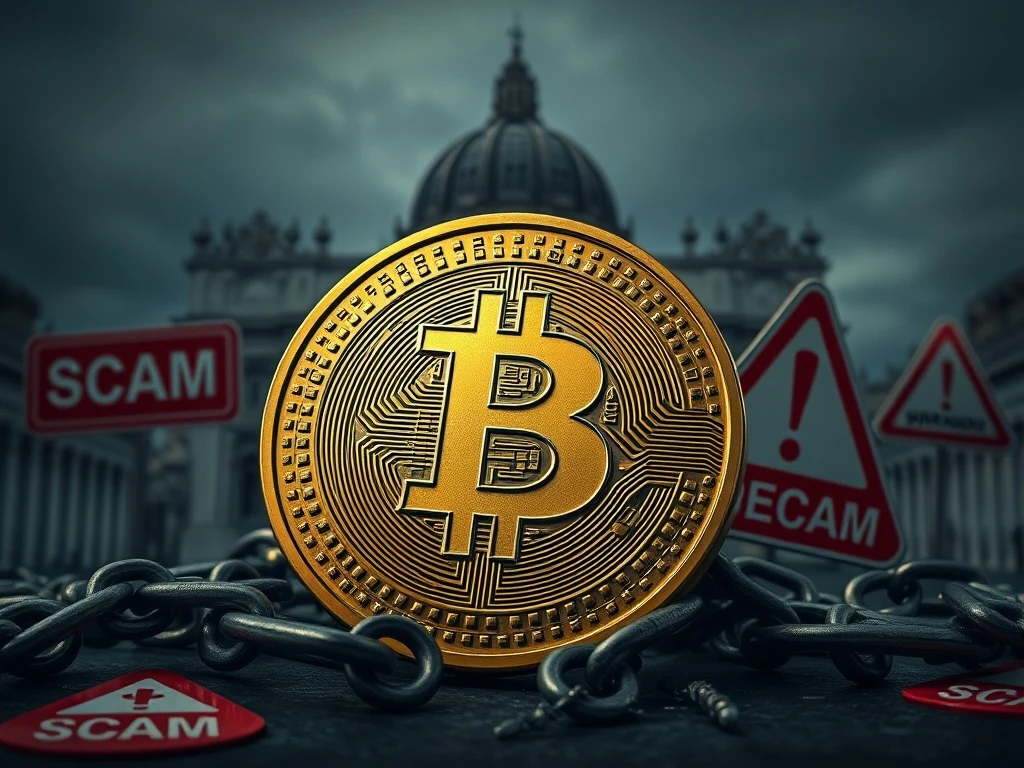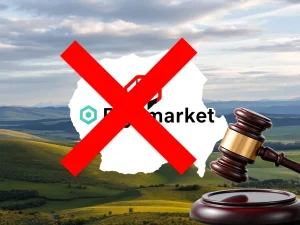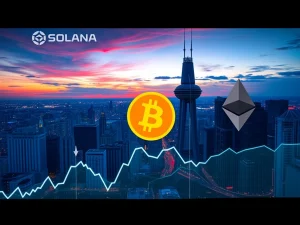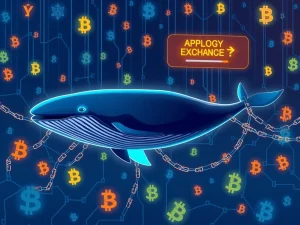URGENT Warning: Vatican Crypto Scam Unmasked – Fake Token Presale Exposed

In the fast-paced world of digital assets, vigilance is paramount. A shocking revelation has sent ripples through the crypto community: a sophisticated Vatican crypto scam attempting to defraud unsuspecting investors. This elaborate scheme, centered around a non-existent “Vatican Chamber of Trade” and a dubious token, serves as a stark reminder that not all that glitters in the blockchain space is gold. Are you ready to uncover the intricate details of this deceptive plot and arm yourself against similar threats?
Unmasking the Vatican Crypto Scam: A Holy Hoax
The Istituto per le Opere di Religione (IOR), widely known as the Vatican Bank, has categorically denied any association with a fraudulent cryptocurrency project. This project brazenly promoted a fake token, the Vatican Chamber Token (VCT), through a deceptive online phishing website. The site made audacious claims, offering a “formal invitation to join one of the world’s most exclusive economic institutions” – the supposed “Vatican Chamber of Trade.”
This scam went to great lengths to appear legitimate, even including the real phone number of the Vatican Bank on its website. However, a direct confirmation from a Vatican Bank representative to Crypto News Insights unequivocally stated, “This project is a scam.” Further investigation revealed that no such institution as the “Vatican Chamber of Trade” exists within the Vatican.
Adding another layer of deceit, a suspicious link was recently inserted into the Vatican Bank’s Wikipedia page, falsely asserting the organization’s creation in 1950. This link, highlighted in red, signaled a lack of source and likely vandalism, with the edit history showing it was added on June 11 as part of a second edit to the page. Such tactics highlight the sophisticated nature of this Vatican crypto scam.
The Deceptive Allure of a Fake Token Presale
The fraudulent website promised prospective members an array of enticing benefits, painting a picture of exclusive access and unparalleled opportunities. These included:
- Private investor introductions
- Custodial holding services
- Enhanced recognition and credibility within elite circles
- Priority access to tokenized asset offerings
- Exclusive events and networking opportunities
Crucially, accepted members were also promised access to a fake token presale of the non-existent VCT tokens. The promoters claimed the VCT token would allow investors to participate in the economic growth of the “Vatican Chamber of Trade,” purportedly backed by a diverse portfolio of tokenized assets and real-world initiatives. The token’s promised total supply was 10 million, with each priced at 25 euros ($29). A circulating supply of 7 million tokens was stated, with 3 million (nearly a third) allocated to a reserve fund for “future development and operational stability.”
A significant red flag appeared when the “buy token” button redirected users to a Coinbase wallet page. While seemingly legitimate, the redirect originated from vaticantrade.cb.id. This suggests the website initially linked to a now-deleted page on the Coinbase-controlled domain cb.id. It’s vital to remember that Coinbase allows any user to claim a “username.cb.id” sub-domain for free, leveraging Ethereum Name Service (ENS) integration without requiring Know Your Customer (KYC) checks. This loophole can be exploited by scammers to create seemingly credible links, making it harder to discern a fake token presale.
Red Flags of Crypto Fraud: What to Watch For
Understanding the common indicators of crypto fraud is essential for safeguarding your investments. The “Vatican Chamber of Trade” scam exhibited several glaring red flags:
- Unrealistic Eligibility Criteria: The website listed stringent requirements, demanding traditional businesses to have a minimum annual revenue of 100,000 euros ($117,000) and crypto projects to possess at least 300,000 euros ($350,000) in total value locked or a verified 500,000 euros ($584,000) in twelve-month cumulative trading volume. While high requirements can signal exclusivity, in this context, they served to filter for high-value targets, making the scam more lucrative for its perpetrators.
- Unverifiable Claims & Lack of Official Sources: The core claim of a “Vatican Chamber of Trade” was entirely fabricated. Always cross-reference any official-sounding claims with direct, verified sources. If a major institution is involved, their official website or press releases should confirm any new initiatives.
- Exaggerated Promises of Returns or Exclusivity: Scammers often lure victims with promises of guaranteed high returns, exclusive access, or unique opportunities that seem too good to be true. The VCT token’s promise of participation in economic growth backed by a diverse portfolio without any verifiable details is a classic sign of crypto fraud.
This incident echoes other high-profile fraud cases in the crypto space. In January, Washington pastor Francier Obando Pinillo was charged with 26 counts of fraud for allegedly stealing from over 1,500 investors through the Solano Fi scheme. These examples underscore the pervasive nature of crypto scams and the need for constant vigilance.
Navigating the Dangers of a Sophisticated Phishing Scam
The “Vatican Chamber of Trade” scheme is more than just a simple misrepresentation; it’s a sophisticated phishing scam designed to extract funds and personal information. Phishing attempts often rely on mimicking legitimate entities to gain trust. Here’s how this scam deployed advanced tactics:
- Domain Mimicry: While not directly mimicking a Vatican domain, the use of a Coinbase sub-domain (
vaticantrade.cb.id) lent a false sense of security and legitimacy, leveraging a reputable brand’s infrastructure. - Wikipedia Vandalism: Tampering with a trusted source like Wikipedia to insert false information about the “Vatican Chamber of Trade” demonstrates a calculated effort to build credibility for the scam.
- Professional Website Design: A well-designed website, complete with detailed eligibility criteria and promises, can easily mislead individuals who don’t perform deep due diligence.
To protect yourself from such a phishing scam, always:
- Verify URLs carefully. Look for official domains and secure connections (HTTPS).
- Be skeptical of unsolicited offers, especially those promising high returns or exclusive access.
- Never share your private keys or sensitive personal information.
- Consult official channels or independent crypto news sources for verification before engaging with any new project.
What You Need to Know About the Vatican Chamber Token (VCT)
Let’s be absolutely clear: the Vatican Chamber Token (VCT) is a fraudulent asset. It has no legitimate backing, no connection to the Vatican Bank or any official Vatican entity, and its promises are entirely fabricated. The concept of it being backed by a “diverse portfolio of tokenized assets and real-world initiatives” is pure fiction designed to give it an air of legitimacy.
Any funds invested in this token would likely be irrecoverable, falling directly into the hands of the scammers. The existence of a specified total supply (10 million) and a per-token price (25 euros) are merely details designed to create the illusion of a tangible asset, encouraging victims to participate in the fake token presale.
Conclusion: Thou Shalt Be Vigilant
The exposure of the fake ‘Vatican Chamber’ token presale serves as a powerful cautionary tale in the cryptocurrency world. It underscores the critical importance of rigorous due diligence, healthy skepticism, and a commitment to verifying information from official and independent sources. In an ecosystem ripe with innovation, it is equally susceptible to sophisticated schemes of crypto fraud and phishing scam attempts. As the digital landscape continues to evolve, so too do the tactics of malicious actors. Your best defense against falling victim to such elaborate hoaxes, including the deceptive Vatican Chamber Token, is unwavering vigilance and an informed approach to every opportunity that comes your way. Remember, if an offer seems too good to be true, it almost certainly is.










